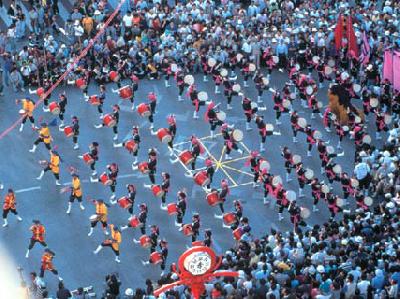|
The Otaru Ushio Festival was inititated in 1967 (Showa 42) in the hope of preserving the history, culture and further development of Otaru, Hokkaido.
The festival is held aroud Otaru Bay for three days on the last weekend (Fri, Sat, Sun) of July. More than a million people from Hokkaido and from outside visit the festival at this time. Ushio chochin lanterns featuring wave patterns are displayed throughout Otaru and the city fills with excitement as the festival begins.
On the second day of the festival, 5,000 dancers from Hokkaido and outside Hokkaido participate in the Ushio-nerikomi parade. The dancers move in time with the rhythm of the Ushio-Ondo, and the parade stirs up more festival excitement.
Meanwhile, various events are held elsewhere in the city, such as the local Ushio taiko drums perfomance. The drums create a rich and enjoyable rhythm. The final day of the festival features a display of 2,500 fireworks set off into the beautiful night sky of the Otaru Bay, marking a spectacular culmination to the festival.
This festival shows a local appreciation of the sea and Otaru's hope for the city's continued development. The afterglow of festival excitement does not disappear for a long time
The festival is held aroud Otaru Bay for three days on the last weekend (Fri, Sat, Sun) of July. More than a million people from Hokkaido and from outside visit the festival at this time. Ushio chochin lanterns featuring wave patterns are displayed throughout Otaru and the city fills with excitement as the festival begins.
On the second day of the festival, 5,000 dancers from Hokkaido and outside Hokkaido participate in the Ushio-nerikomi parade. The dancers move in time with the rhythm of the Ushio-Ondo, and the parade stirs up more festival excitement.
Meanwhile, various events are held elsewhere in the city, such as the local Ushio taiko drums perfomance. The drums create a rich and enjoyable rhythm. The final day of the festival features a display of 2,500 fireworks set off into the beautiful night sky of the Otaru Bay, marking a spectacular culmination to the festival.
This festival shows a local appreciation of the sea and Otaru's hope for the city's continued development. The afterglow of festival excitement does not disappear for a long time
| [+ADDRESS] | 
|















